Strategic Analysis of the US Airlines Industry: A Case Study Report
VerifiedAdded on 2023/01/17
|13
|3425
|30
Report
AI Summary
This report provides a comprehensive analysis of the US airlines industry, focusing on the competitive landscape and strategic challenges faced by major players. It begins with an executive summary and table of contents, followed by an introduction that highlights the industry's struggles with profitability due to increased competition from low-cost carriers. The report then delves into the external environment using PESTEL analysis, examining political, economic, social, technological, environmental, and legal factors affecting the industry. Furthermore, it applies Porter's Five Forces framework to assess the industry's attractiveness and competitive dynamics, including supplier power, buyer power, and the threat of new entrants. The report also identifies key drivers of change, opportunities, and threats for US airlines, concluding with recommendations for improving profitability and competitiveness.
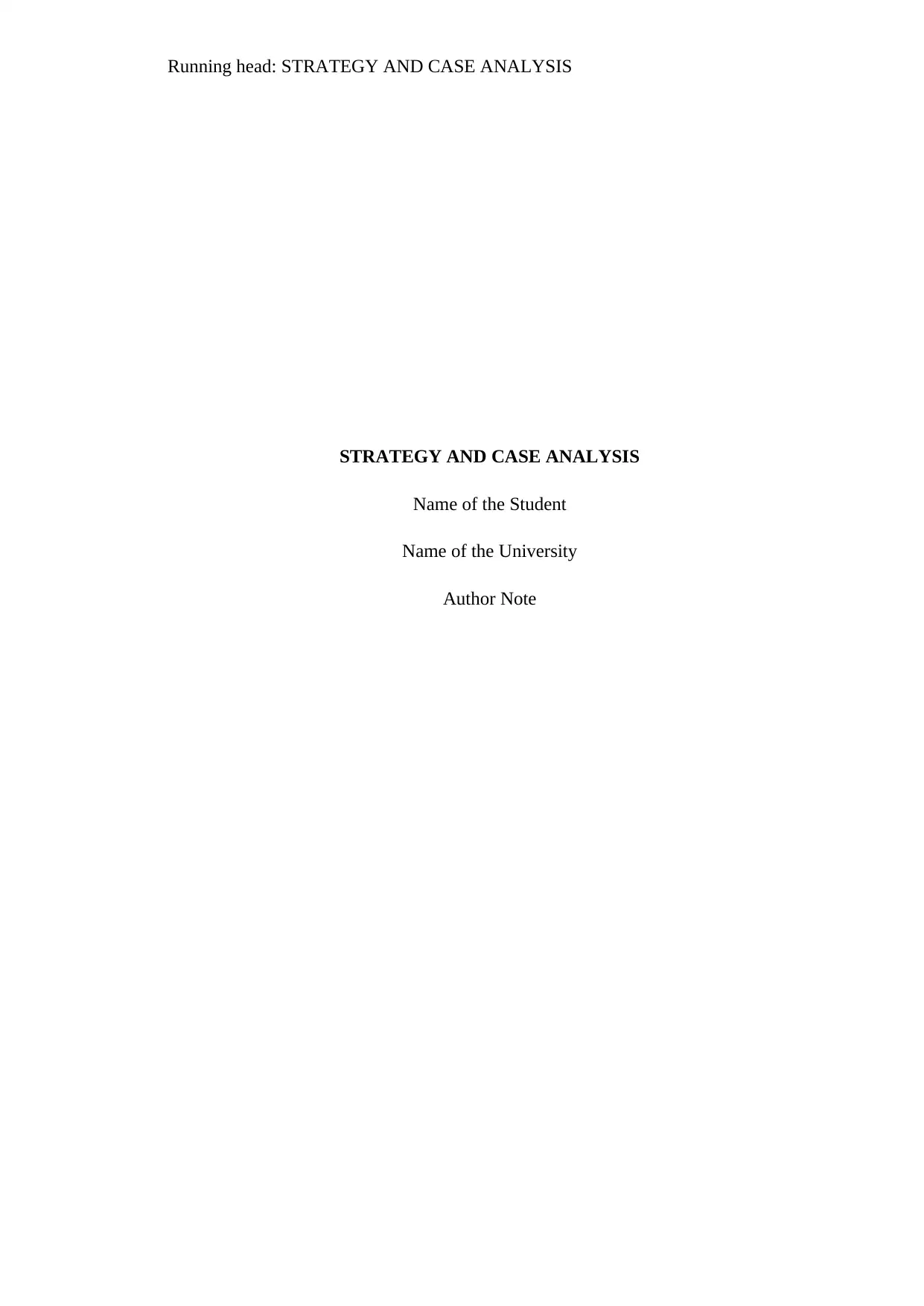
Running head: STRATEGY AND CASE ANALYSIS
STRATEGY AND CASE ANALYSIS
Name of the Student
Name of the University
Author Note
STRATEGY AND CASE ANALYSIS
Name of the Student
Name of the University
Author Note
Paraphrase This Document
Need a fresh take? Get an instant paraphrase of this document with our AI Paraphraser

1STRATEGY AND CASE ANALYSIS
Executive Summary
The report is based on the analysis of the US airlines industry and changes that have taken
place due to increase in competition from the small organizations. The external environment
based factors have been analysed with the help of PESTLE framework. The operations of
airlines industry and different forces that have affected the organizations are analysed with
the implementation of Porter’s five forces framework. The report has also provided a detailed
analysis based on the major drivers of change in the US airlines based industry.
Recommendations have also been provided based on the ways by which changes can be made
in the organization in order to increase profitability in the industry.
Executive Summary
The report is based on the analysis of the US airlines industry and changes that have taken
place due to increase in competition from the small organizations. The external environment
based factors have been analysed with the help of PESTLE framework. The operations of
airlines industry and different forces that have affected the organizations are analysed with
the implementation of Porter’s five forces framework. The report has also provided a detailed
analysis based on the major drivers of change in the US airlines based industry.
Recommendations have also been provided based on the ways by which changes can be made
in the organization in order to increase profitability in the industry.
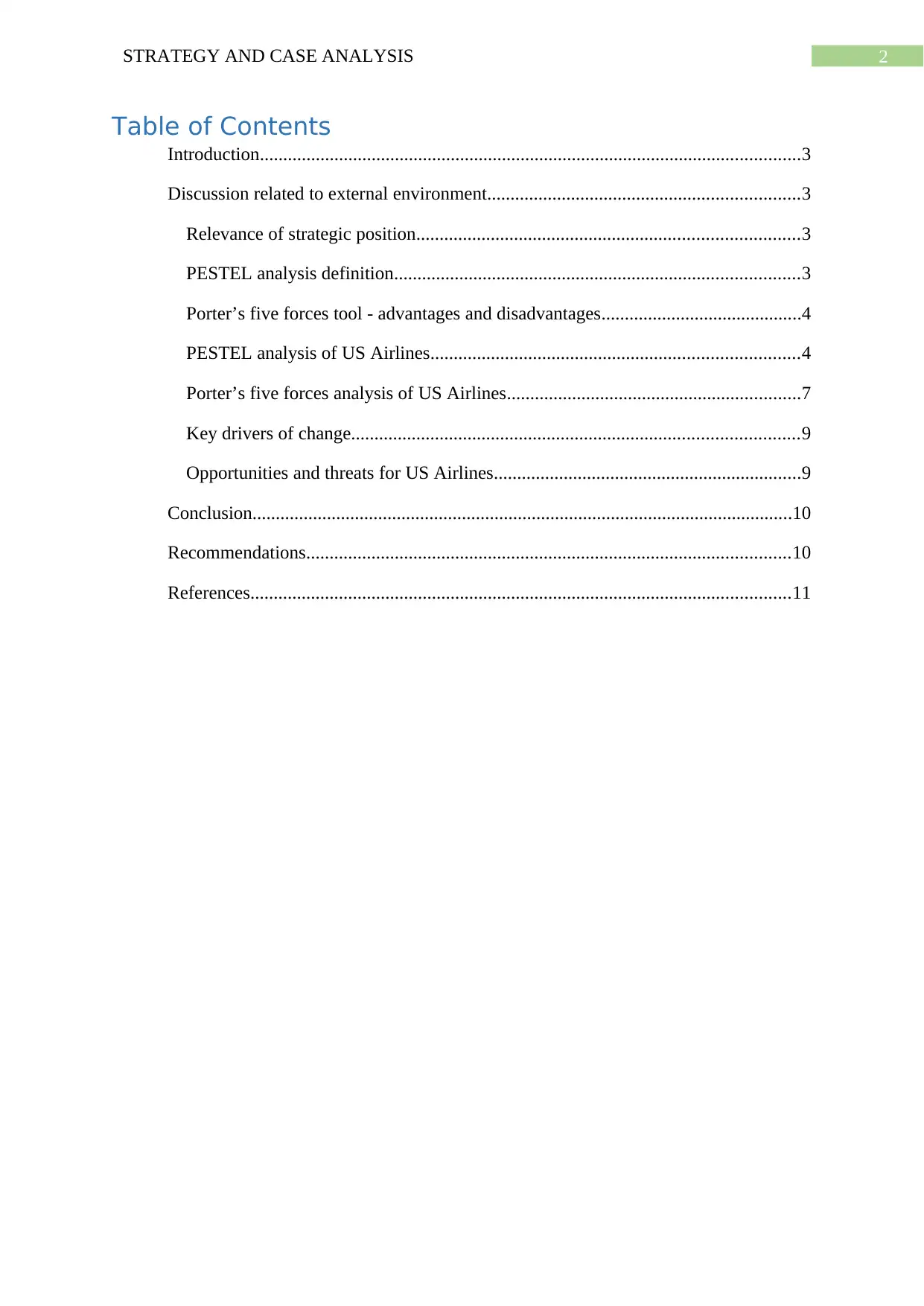
2STRATEGY AND CASE ANALYSIS
Table of Contents
Introduction....................................................................................................................3
Discussion related to external environment...................................................................3
Relevance of strategic position..................................................................................3
PESTEL analysis definition.......................................................................................3
Porter’s five forces tool - advantages and disadvantages...........................................4
PESTEL analysis of US Airlines...............................................................................4
Porter’s five forces analysis of US Airlines...............................................................7
Key drivers of change................................................................................................9
Opportunities and threats for US Airlines..................................................................9
Conclusion....................................................................................................................10
Recommendations........................................................................................................10
References....................................................................................................................11
Table of Contents
Introduction....................................................................................................................3
Discussion related to external environment...................................................................3
Relevance of strategic position..................................................................................3
PESTEL analysis definition.......................................................................................3
Porter’s five forces tool - advantages and disadvantages...........................................4
PESTEL analysis of US Airlines...............................................................................4
Porter’s five forces analysis of US Airlines...............................................................7
Key drivers of change................................................................................................9
Opportunities and threats for US Airlines..................................................................9
Conclusion....................................................................................................................10
Recommendations........................................................................................................10
References....................................................................................................................11
⊘ This is a preview!⊘
Do you want full access?
Subscribe today to unlock all pages.

Trusted by 1+ million students worldwide
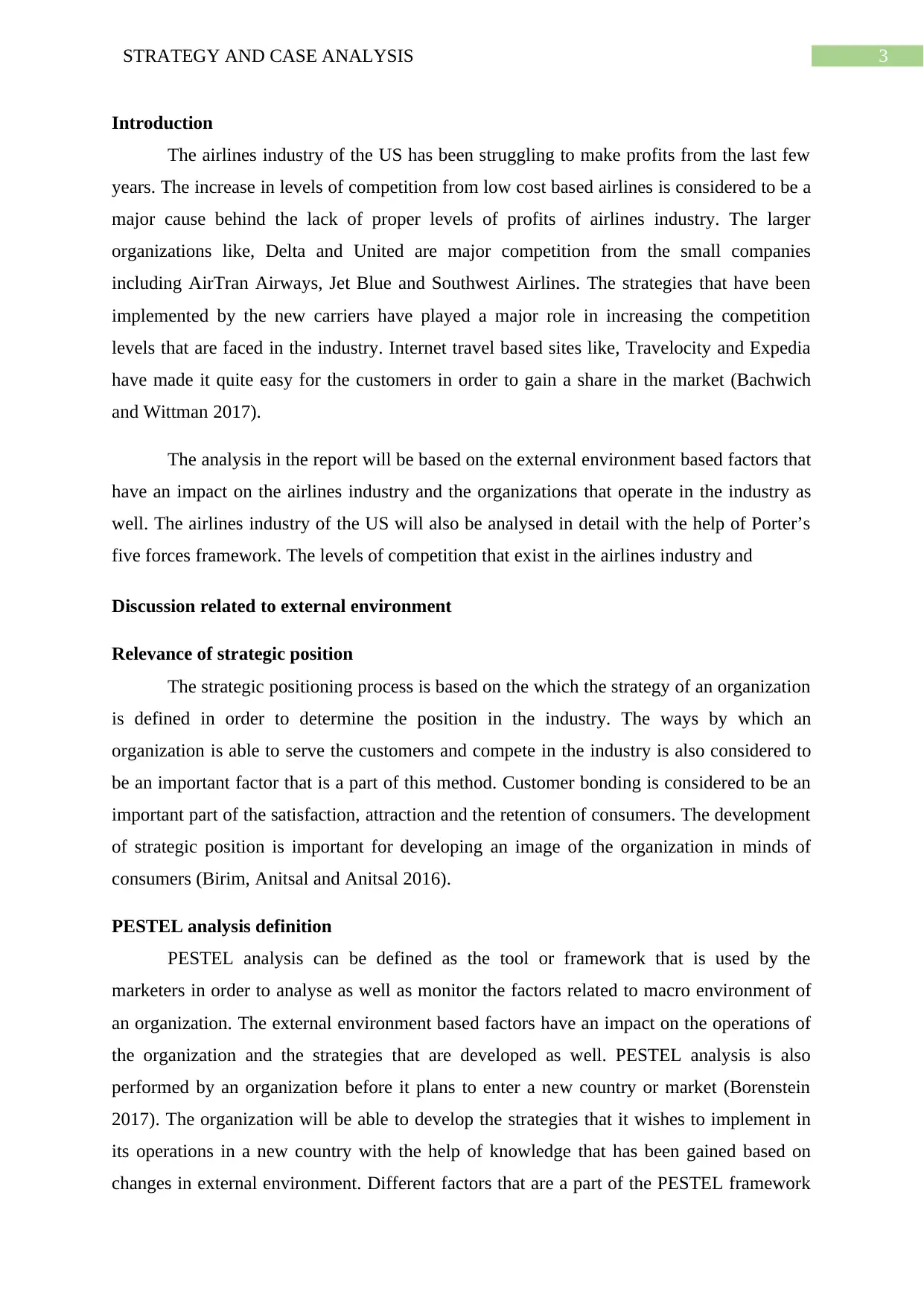
3STRATEGY AND CASE ANALYSIS
Introduction
The airlines industry of the US has been struggling to make profits from the last few
years. The increase in levels of competition from low cost based airlines is considered to be a
major cause behind the lack of proper levels of profits of airlines industry. The larger
organizations like, Delta and United are major competition from the small companies
including AirTran Airways, Jet Blue and Southwest Airlines. The strategies that have been
implemented by the new carriers have played a major role in increasing the competition
levels that are faced in the industry. Internet travel based sites like, Travelocity and Expedia
have made it quite easy for the customers in order to gain a share in the market (Bachwich
and Wittman 2017).
The analysis in the report will be based on the external environment based factors that
have an impact on the airlines industry and the organizations that operate in the industry as
well. The airlines industry of the US will also be analysed in detail with the help of Porter’s
five forces framework. The levels of competition that exist in the airlines industry and
Discussion related to external environment
Relevance of strategic position
The strategic positioning process is based on the which the strategy of an organization
is defined in order to determine the position in the industry. The ways by which an
organization is able to serve the customers and compete in the industry is also considered to
be an important factor that is a part of this method. Customer bonding is considered to be an
important part of the satisfaction, attraction and the retention of consumers. The development
of strategic position is important for developing an image of the organization in minds of
consumers (Birim, Anitsal and Anitsal 2016).
PESTEL analysis definition
PESTEL analysis can be defined as the tool or framework that is used by the
marketers in order to analyse as well as monitor the factors related to macro environment of
an organization. The external environment based factors have an impact on the operations of
the organization and the strategies that are developed as well. PESTEL analysis is also
performed by an organization before it plans to enter a new country or market (Borenstein
2017). The organization will be able to develop the strategies that it wishes to implement in
its operations in a new country with the help of knowledge that has been gained based on
changes in external environment. Different factors that are a part of the PESTEL framework
Introduction
The airlines industry of the US has been struggling to make profits from the last few
years. The increase in levels of competition from low cost based airlines is considered to be a
major cause behind the lack of proper levels of profits of airlines industry. The larger
organizations like, Delta and United are major competition from the small companies
including AirTran Airways, Jet Blue and Southwest Airlines. The strategies that have been
implemented by the new carriers have played a major role in increasing the competition
levels that are faced in the industry. Internet travel based sites like, Travelocity and Expedia
have made it quite easy for the customers in order to gain a share in the market (Bachwich
and Wittman 2017).
The analysis in the report will be based on the external environment based factors that
have an impact on the airlines industry and the organizations that operate in the industry as
well. The airlines industry of the US will also be analysed in detail with the help of Porter’s
five forces framework. The levels of competition that exist in the airlines industry and
Discussion related to external environment
Relevance of strategic position
The strategic positioning process is based on the which the strategy of an organization
is defined in order to determine the position in the industry. The ways by which an
organization is able to serve the customers and compete in the industry is also considered to
be an important factor that is a part of this method. Customer bonding is considered to be an
important part of the satisfaction, attraction and the retention of consumers. The development
of strategic position is important for developing an image of the organization in minds of
consumers (Birim, Anitsal and Anitsal 2016).
PESTEL analysis definition
PESTEL analysis can be defined as the tool or framework that is used by the
marketers in order to analyse as well as monitor the factors related to macro environment of
an organization. The external environment based factors have an impact on the operations of
the organization and the strategies that are developed as well. PESTEL analysis is also
performed by an organization before it plans to enter a new country or market (Borenstein
2017). The organization will be able to develop the strategies that it wishes to implement in
its operations in a new country with the help of knowledge that has been gained based on
changes in external environment. Different factors that are a part of the PESTEL framework
Paraphrase This Document
Need a fresh take? Get an instant paraphrase of this document with our AI Paraphraser
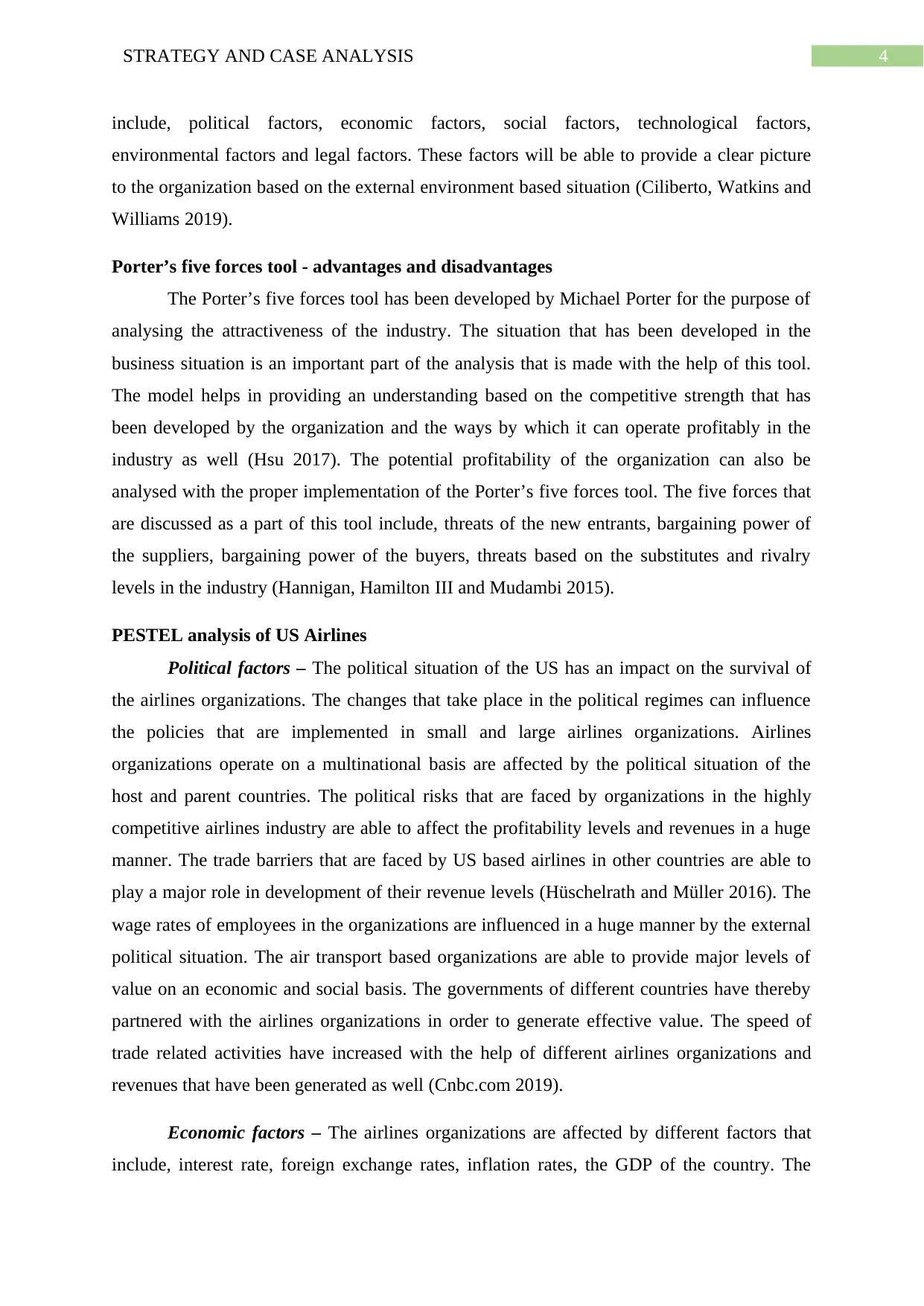
4STRATEGY AND CASE ANALYSIS
include, political factors, economic factors, social factors, technological factors,
environmental factors and legal factors. These factors will be able to provide a clear picture
to the organization based on the external environment based situation (Ciliberto, Watkins and
Williams 2019).
Porter’s five forces tool - advantages and disadvantages
The Porter’s five forces tool has been developed by Michael Porter for the purpose of
analysing the attractiveness of the industry. The situation that has been developed in the
business situation is an important part of the analysis that is made with the help of this tool.
The model helps in providing an understanding based on the competitive strength that has
been developed by the organization and the ways by which it can operate profitably in the
industry as well (Hsu 2017). The potential profitability of the organization can also be
analysed with the proper implementation of the Porter’s five forces tool. The five forces that
are discussed as a part of this tool include, threats of the new entrants, bargaining power of
the suppliers, bargaining power of the buyers, threats based on the substitutes and rivalry
levels in the industry (Hannigan, Hamilton III and Mudambi 2015).
PESTEL analysis of US Airlines
Political factors – The political situation of the US has an impact on the survival of
the airlines organizations. The changes that take place in the political regimes can influence
the policies that are implemented in small and large airlines organizations. Airlines
organizations operate on a multinational basis are affected by the political situation of the
host and parent countries. The political risks that are faced by organizations in the highly
competitive airlines industry are able to affect the profitability levels and revenues in a huge
manner. The trade barriers that are faced by US based airlines in other countries are able to
play a major role in development of their revenue levels (Hüschelrath and Müller 2016). The
wage rates of employees in the organizations are influenced in a huge manner by the external
political situation. The air transport based organizations are able to provide major levels of
value on an economic and social basis. The governments of different countries have thereby
partnered with the airlines organizations in order to generate effective value. The speed of
trade related activities have increased with the help of different airlines organizations and
revenues that have been generated as well (Cnbc.com 2019).
Economic factors – The airlines organizations are affected by different factors that
include, interest rate, foreign exchange rates, inflation rates, the GDP of the country. The
include, political factors, economic factors, social factors, technological factors,
environmental factors and legal factors. These factors will be able to provide a clear picture
to the organization based on the external environment based situation (Ciliberto, Watkins and
Williams 2019).
Porter’s five forces tool - advantages and disadvantages
The Porter’s five forces tool has been developed by Michael Porter for the purpose of
analysing the attractiveness of the industry. The situation that has been developed in the
business situation is an important part of the analysis that is made with the help of this tool.
The model helps in providing an understanding based on the competitive strength that has
been developed by the organization and the ways by which it can operate profitably in the
industry as well (Hsu 2017). The potential profitability of the organization can also be
analysed with the proper implementation of the Porter’s five forces tool. The five forces that
are discussed as a part of this tool include, threats of the new entrants, bargaining power of
the suppliers, bargaining power of the buyers, threats based on the substitutes and rivalry
levels in the industry (Hannigan, Hamilton III and Mudambi 2015).
PESTEL analysis of US Airlines
Political factors – The political situation of the US has an impact on the survival of
the airlines organizations. The changes that take place in the political regimes can influence
the policies that are implemented in small and large airlines organizations. Airlines
organizations operate on a multinational basis are affected by the political situation of the
host and parent countries. The political risks that are faced by organizations in the highly
competitive airlines industry are able to affect the profitability levels and revenues in a huge
manner. The trade barriers that are faced by US based airlines in other countries are able to
play a major role in development of their revenue levels (Hüschelrath and Müller 2016). The
wage rates of employees in the organizations are influenced in a huge manner by the external
political situation. The air transport based organizations are able to provide major levels of
value on an economic and social basis. The governments of different countries have thereby
partnered with the airlines organizations in order to generate effective value. The speed of
trade related activities have increased with the help of different airlines organizations and
revenues that have been generated as well (Cnbc.com 2019).
Economic factors – The airlines organizations are affected by different factors that
include, interest rate, foreign exchange rates, inflation rates, the GDP of the country. The
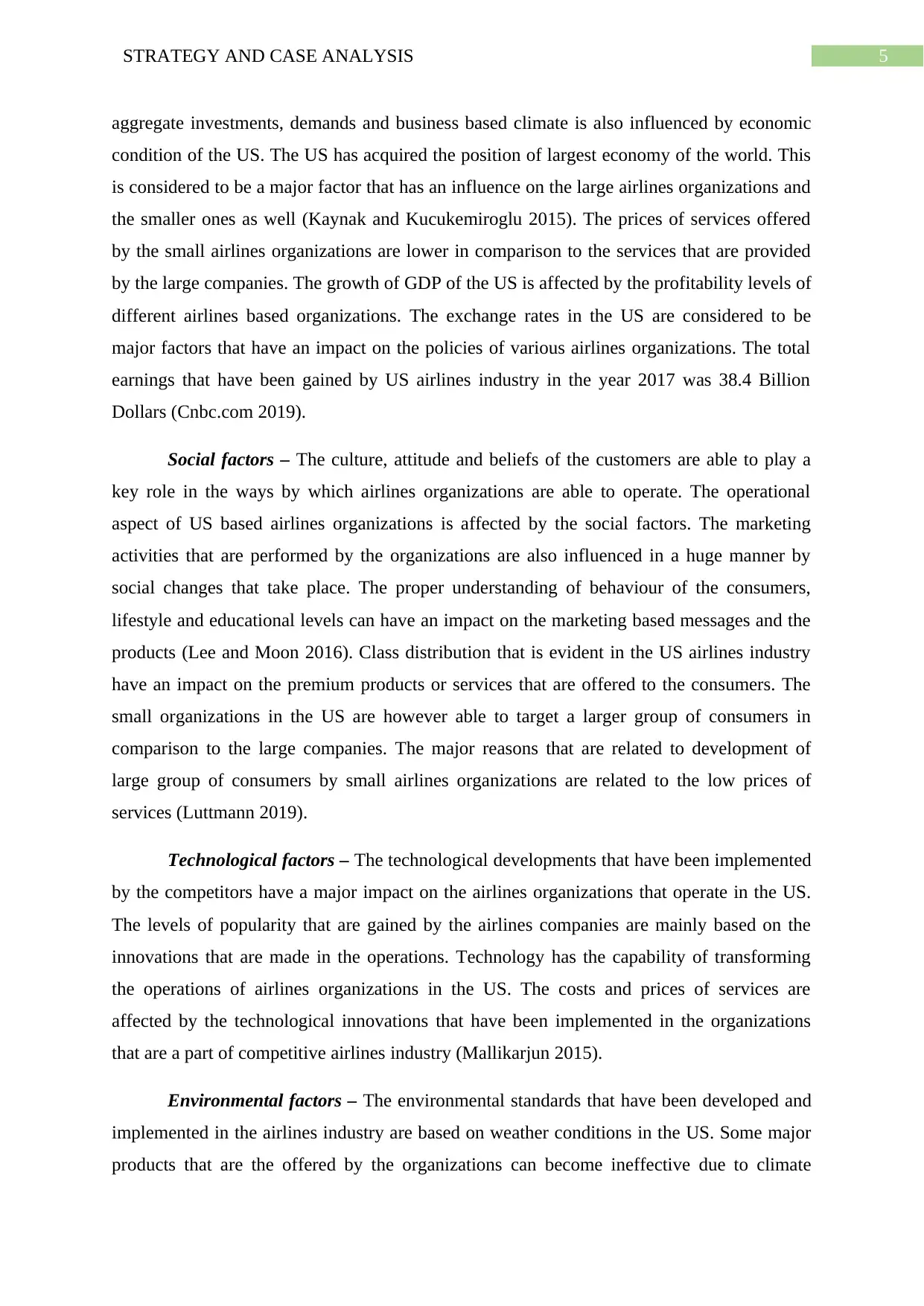
5STRATEGY AND CASE ANALYSIS
aggregate investments, demands and business based climate is also influenced by economic
condition of the US. The US has acquired the position of largest economy of the world. This
is considered to be a major factor that has an influence on the large airlines organizations and
the smaller ones as well (Kaynak and Kucukemiroglu 2015). The prices of services offered
by the small airlines organizations are lower in comparison to the services that are provided
by the large companies. The growth of GDP of the US is affected by the profitability levels of
different airlines based organizations. The exchange rates in the US are considered to be
major factors that have an impact on the policies of various airlines organizations. The total
earnings that have been gained by US airlines industry in the year 2017 was 38.4 Billion
Dollars (Cnbc.com 2019).
Social factors – The culture, attitude and beliefs of the customers are able to play a
key role in the ways by which airlines organizations are able to operate. The operational
aspect of US based airlines organizations is affected by the social factors. The marketing
activities that are performed by the organizations are also influenced in a huge manner by
social changes that take place. The proper understanding of behaviour of the consumers,
lifestyle and educational levels can have an impact on the marketing based messages and the
products (Lee and Moon 2016). Class distribution that is evident in the US airlines industry
have an impact on the premium products or services that are offered to the consumers. The
small organizations in the US are however able to target a larger group of consumers in
comparison to the large companies. The major reasons that are related to development of
large group of consumers by small airlines organizations are related to the low prices of
services (Luttmann 2019).
Technological factors – The technological developments that have been implemented
by the competitors have a major impact on the airlines organizations that operate in the US.
The levels of popularity that are gained by the airlines companies are mainly based on the
innovations that are made in the operations. Technology has the capability of transforming
the operations of airlines organizations in the US. The costs and prices of services are
affected by the technological innovations that have been implemented in the organizations
that are a part of competitive airlines industry (Mallikarjun 2015).
Environmental factors – The environmental standards that have been developed and
implemented in the airlines industry are based on weather conditions in the US. Some major
products that are the offered by the organizations can become ineffective due to climate
aggregate investments, demands and business based climate is also influenced by economic
condition of the US. The US has acquired the position of largest economy of the world. This
is considered to be a major factor that has an influence on the large airlines organizations and
the smaller ones as well (Kaynak and Kucukemiroglu 2015). The prices of services offered
by the small airlines organizations are lower in comparison to the services that are provided
by the large companies. The growth of GDP of the US is affected by the profitability levels of
different airlines based organizations. The exchange rates in the US are considered to be
major factors that have an impact on the policies of various airlines organizations. The total
earnings that have been gained by US airlines industry in the year 2017 was 38.4 Billion
Dollars (Cnbc.com 2019).
Social factors – The culture, attitude and beliefs of the customers are able to play a
key role in the ways by which airlines organizations are able to operate. The operational
aspect of US based airlines organizations is affected by the social factors. The marketing
activities that are performed by the organizations are also influenced in a huge manner by
social changes that take place. The proper understanding of behaviour of the consumers,
lifestyle and educational levels can have an impact on the marketing based messages and the
products (Lee and Moon 2016). Class distribution that is evident in the US airlines industry
have an impact on the premium products or services that are offered to the consumers. The
small organizations in the US are however able to target a larger group of consumers in
comparison to the large companies. The major reasons that are related to development of
large group of consumers by small airlines organizations are related to the low prices of
services (Luttmann 2019).
Technological factors – The technological developments that have been implemented
by the competitors have a major impact on the airlines organizations that operate in the US.
The levels of popularity that are gained by the airlines companies are mainly based on the
innovations that are made in the operations. Technology has the capability of transforming
the operations of airlines organizations in the US. The costs and prices of services are
affected by the technological innovations that have been implemented in the organizations
that are a part of competitive airlines industry (Mallikarjun 2015).
Environmental factors – The environmental standards that have been developed and
implemented in the airlines industry are based on weather conditions in the US. Some major
products that are the offered by the organizations can become ineffective due to climate
⊘ This is a preview!⊘
Do you want full access?
Subscribe today to unlock all pages.

Trusted by 1+ million students worldwide
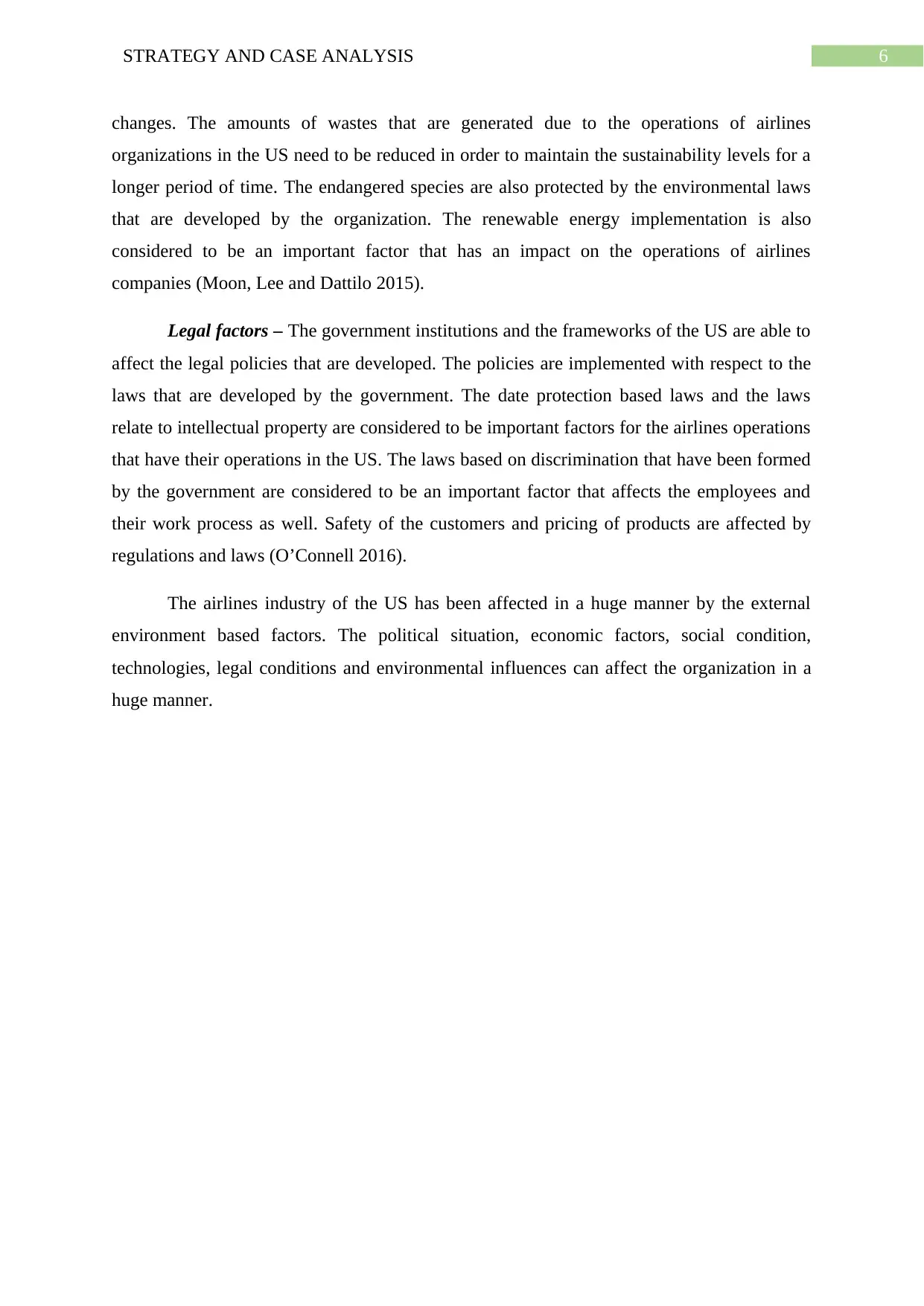
6STRATEGY AND CASE ANALYSIS
changes. The amounts of wastes that are generated due to the operations of airlines
organizations in the US need to be reduced in order to maintain the sustainability levels for a
longer period of time. The endangered species are also protected by the environmental laws
that are developed by the organization. The renewable energy implementation is also
considered to be an important factor that has an impact on the operations of airlines
companies (Moon, Lee and Dattilo 2015).
Legal factors – The government institutions and the frameworks of the US are able to
affect the legal policies that are developed. The policies are implemented with respect to the
laws that are developed by the government. The date protection based laws and the laws
relate to intellectual property are considered to be important factors for the airlines operations
that have their operations in the US. The laws based on discrimination that have been formed
by the government are considered to be an important factor that affects the employees and
their work process as well. Safety of the customers and pricing of products are affected by
regulations and laws (O’Connell 2016).
The airlines industry of the US has been affected in a huge manner by the external
environment based factors. The political situation, economic factors, social condition,
technologies, legal conditions and environmental influences can affect the organization in a
huge manner.
changes. The amounts of wastes that are generated due to the operations of airlines
organizations in the US need to be reduced in order to maintain the sustainability levels for a
longer period of time. The endangered species are also protected by the environmental laws
that are developed by the organization. The renewable energy implementation is also
considered to be an important factor that has an impact on the operations of airlines
companies (Moon, Lee and Dattilo 2015).
Legal factors – The government institutions and the frameworks of the US are able to
affect the legal policies that are developed. The policies are implemented with respect to the
laws that are developed by the government. The date protection based laws and the laws
relate to intellectual property are considered to be important factors for the airlines operations
that have their operations in the US. The laws based on discrimination that have been formed
by the government are considered to be an important factor that affects the employees and
their work process as well. Safety of the customers and pricing of products are affected by
regulations and laws (O’Connell 2016).
The airlines industry of the US has been affected in a huge manner by the external
environment based factors. The political situation, economic factors, social condition,
technologies, legal conditions and environmental influences can affect the organization in a
huge manner.
Paraphrase This Document
Need a fresh take? Get an instant paraphrase of this document with our AI Paraphraser
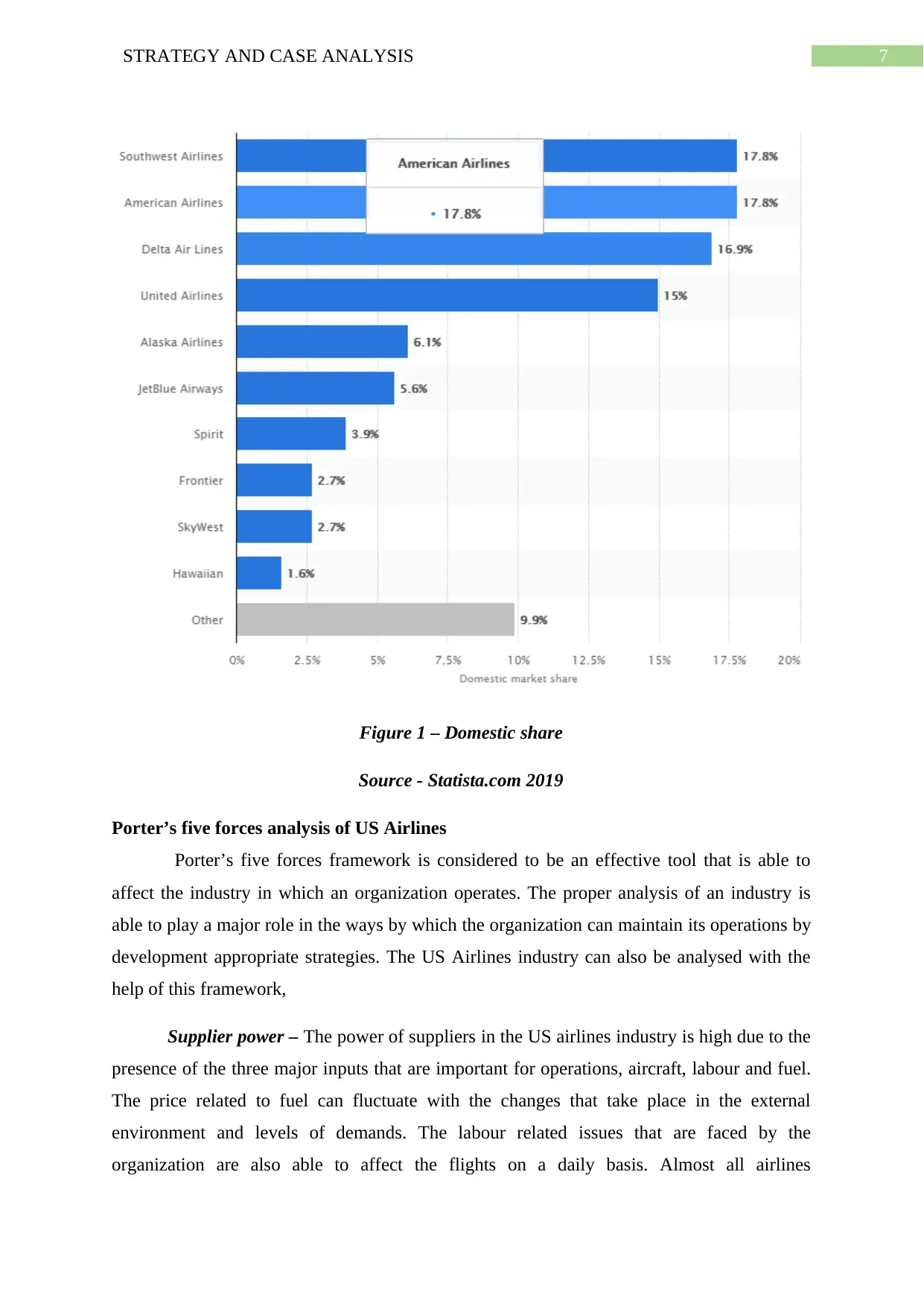
7STRATEGY AND CASE ANALYSIS
Figure 1 – Domestic share
Source - Statista.com 2019
Porter’s five forces analysis of US Airlines
Porter’s five forces framework is considered to be an effective tool that is able to
affect the industry in which an organization operates. The proper analysis of an industry is
able to play a major role in the ways by which the organization can maintain its operations by
development appropriate strategies. The US Airlines industry can also be analysed with the
help of this framework,
Supplier power – The power of suppliers in the US airlines industry is high due to the
presence of the three major inputs that are important for operations, aircraft, labour and fuel.
The price related to fuel can fluctuate with the changes that take place in the external
environment and levels of demands. The labour related issues that are faced by the
organization are also able to affect the flights on a daily basis. Almost all airlines
Figure 1 – Domestic share
Source - Statista.com 2019
Porter’s five forces analysis of US Airlines
Porter’s five forces framework is considered to be an effective tool that is able to
affect the industry in which an organization operates. The proper analysis of an industry is
able to play a major role in the ways by which the organization can maintain its operations by
development appropriate strategies. The US Airlines industry can also be analysed with the
help of this framework,
Supplier power – The power of suppliers in the US airlines industry is high due to the
presence of the three major inputs that are important for operations, aircraft, labour and fuel.
The price related to fuel can fluctuate with the changes that take place in the external
environment and levels of demands. The labour related issues that are faced by the
organization are also able to affect the flights on a daily basis. Almost all airlines
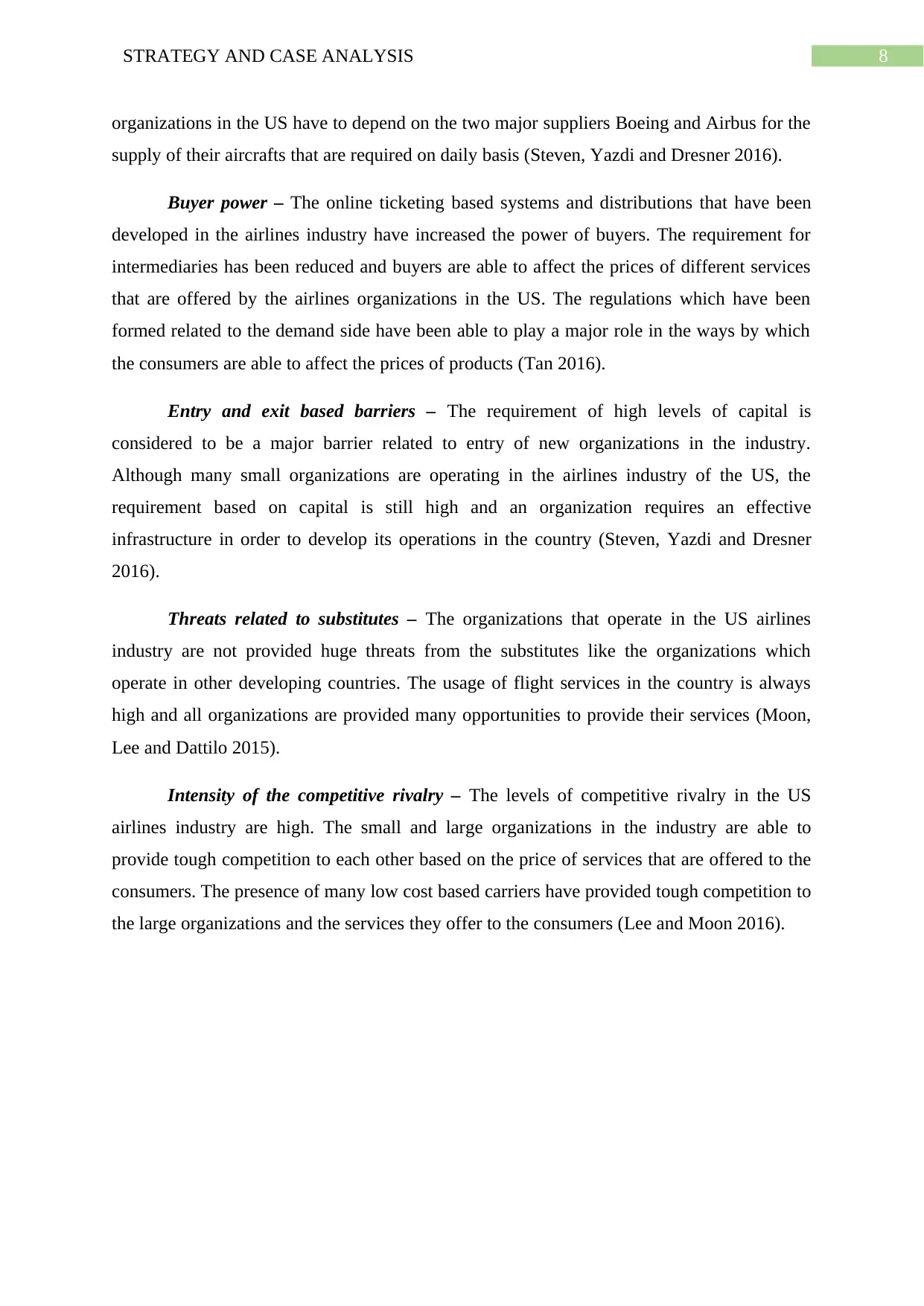
8STRATEGY AND CASE ANALYSIS
organizations in the US have to depend on the two major suppliers Boeing and Airbus for the
supply of their aircrafts that are required on daily basis (Steven, Yazdi and Dresner 2016).
Buyer power – The online ticketing based systems and distributions that have been
developed in the airlines industry have increased the power of buyers. The requirement for
intermediaries has been reduced and buyers are able to affect the prices of different services
that are offered by the airlines organizations in the US. The regulations which have been
formed related to the demand side have been able to play a major role in the ways by which
the consumers are able to affect the prices of products (Tan 2016).
Entry and exit based barriers – The requirement of high levels of capital is
considered to be a major barrier related to entry of new organizations in the industry.
Although many small organizations are operating in the airlines industry of the US, the
requirement based on capital is still high and an organization requires an effective
infrastructure in order to develop its operations in the country (Steven, Yazdi and Dresner
2016).
Threats related to substitutes – The organizations that operate in the US airlines
industry are not provided huge threats from the substitutes like the organizations which
operate in other developing countries. The usage of flight services in the country is always
high and all organizations are provided many opportunities to provide their services (Moon,
Lee and Dattilo 2015).
Intensity of the competitive rivalry – The levels of competitive rivalry in the US
airlines industry are high. The small and large organizations in the industry are able to
provide tough competition to each other based on the price of services that are offered to the
consumers. The presence of many low cost based carriers have provided tough competition to
the large organizations and the services they offer to the consumers (Lee and Moon 2016).
organizations in the US have to depend on the two major suppliers Boeing and Airbus for the
supply of their aircrafts that are required on daily basis (Steven, Yazdi and Dresner 2016).
Buyer power – The online ticketing based systems and distributions that have been
developed in the airlines industry have increased the power of buyers. The requirement for
intermediaries has been reduced and buyers are able to affect the prices of different services
that are offered by the airlines organizations in the US. The regulations which have been
formed related to the demand side have been able to play a major role in the ways by which
the consumers are able to affect the prices of products (Tan 2016).
Entry and exit based barriers – The requirement of high levels of capital is
considered to be a major barrier related to entry of new organizations in the industry.
Although many small organizations are operating in the airlines industry of the US, the
requirement based on capital is still high and an organization requires an effective
infrastructure in order to develop its operations in the country (Steven, Yazdi and Dresner
2016).
Threats related to substitutes – The organizations that operate in the US airlines
industry are not provided huge threats from the substitutes like the organizations which
operate in other developing countries. The usage of flight services in the country is always
high and all organizations are provided many opportunities to provide their services (Moon,
Lee and Dattilo 2015).
Intensity of the competitive rivalry – The levels of competitive rivalry in the US
airlines industry are high. The small and large organizations in the industry are able to
provide tough competition to each other based on the price of services that are offered to the
consumers. The presence of many low cost based carriers have provided tough competition to
the large organizations and the services they offer to the consumers (Lee and Moon 2016).
⊘ This is a preview!⊘
Do you want full access?
Subscribe today to unlock all pages.

Trusted by 1+ million students worldwide
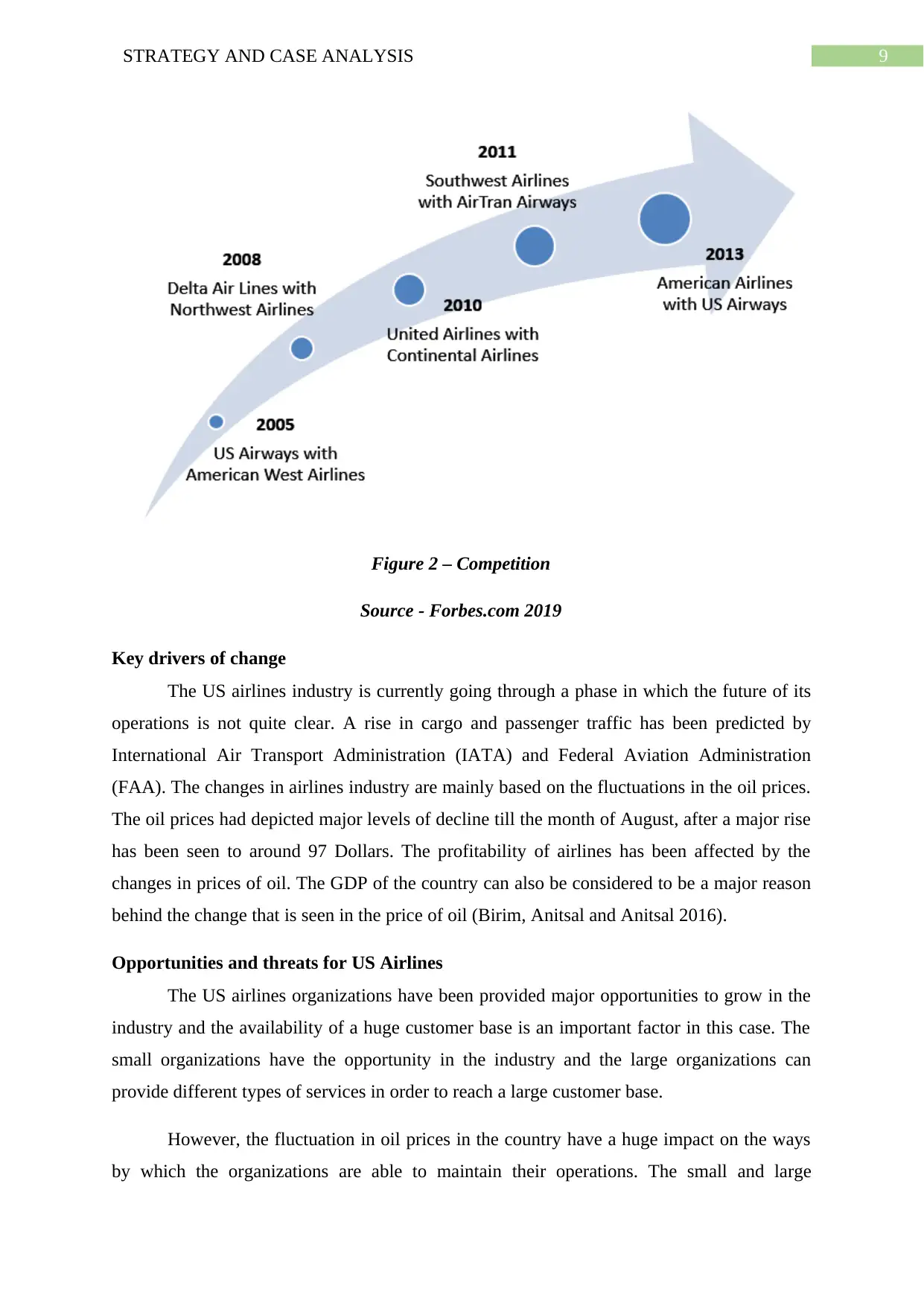
9STRATEGY AND CASE ANALYSIS
Figure 2 – Competition
Source - Forbes.com 2019
Key drivers of change
The US airlines industry is currently going through a phase in which the future of its
operations is not quite clear. A rise in cargo and passenger traffic has been predicted by
International Air Transport Administration (IATA) and Federal Aviation Administration
(FAA). The changes in airlines industry are mainly based on the fluctuations in the oil prices.
The oil prices had depicted major levels of decline till the month of August, after a major rise
has been seen to around 97 Dollars. The profitability of airlines has been affected by the
changes in prices of oil. The GDP of the country can also be considered to be a major reason
behind the change that is seen in the price of oil (Birim, Anitsal and Anitsal 2016).
Opportunities and threats for US Airlines
The US airlines organizations have been provided major opportunities to grow in the
industry and the availability of a huge customer base is an important factor in this case. The
small organizations have the opportunity in the industry and the large organizations can
provide different types of services in order to reach a large customer base.
However, the fluctuation in oil prices in the country have a huge impact on the ways
by which the organizations are able to maintain their operations. The small and large
Figure 2 – Competition
Source - Forbes.com 2019
Key drivers of change
The US airlines industry is currently going through a phase in which the future of its
operations is not quite clear. A rise in cargo and passenger traffic has been predicted by
International Air Transport Administration (IATA) and Federal Aviation Administration
(FAA). The changes in airlines industry are mainly based on the fluctuations in the oil prices.
The oil prices had depicted major levels of decline till the month of August, after a major rise
has been seen to around 97 Dollars. The profitability of airlines has been affected by the
changes in prices of oil. The GDP of the country can also be considered to be a major reason
behind the change that is seen in the price of oil (Birim, Anitsal and Anitsal 2016).
Opportunities and threats for US Airlines
The US airlines organizations have been provided major opportunities to grow in the
industry and the availability of a huge customer base is an important factor in this case. The
small organizations have the opportunity in the industry and the large organizations can
provide different types of services in order to reach a large customer base.
However, the fluctuation in oil prices in the country have a huge impact on the ways
by which the organizations are able to maintain their operations. The small and large
Paraphrase This Document
Need a fresh take? Get an instant paraphrase of this document with our AI Paraphraser
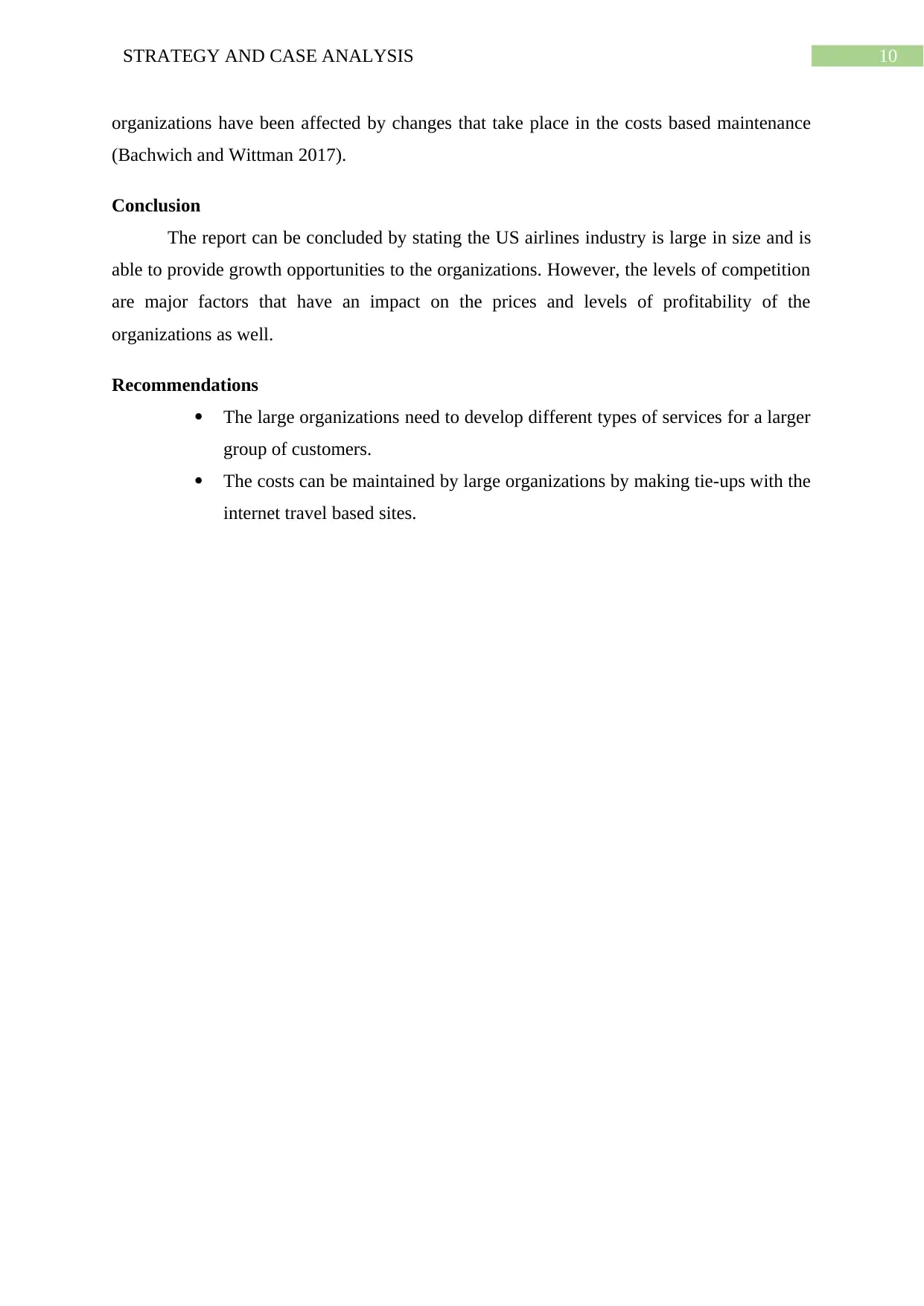
10STRATEGY AND CASE ANALYSIS
organizations have been affected by changes that take place in the costs based maintenance
(Bachwich and Wittman 2017).
Conclusion
The report can be concluded by stating the US airlines industry is large in size and is
able to provide growth opportunities to the organizations. However, the levels of competition
are major factors that have an impact on the prices and levels of profitability of the
organizations as well.
Recommendations
The large organizations need to develop different types of services for a larger
group of customers.
The costs can be maintained by large organizations by making tie-ups with the
internet travel based sites.
organizations have been affected by changes that take place in the costs based maintenance
(Bachwich and Wittman 2017).
Conclusion
The report can be concluded by stating the US airlines industry is large in size and is
able to provide growth opportunities to the organizations. However, the levels of competition
are major factors that have an impact on the prices and levels of profitability of the
organizations as well.
Recommendations
The large organizations need to develop different types of services for a larger
group of customers.
The costs can be maintained by large organizations by making tie-ups with the
internet travel based sites.
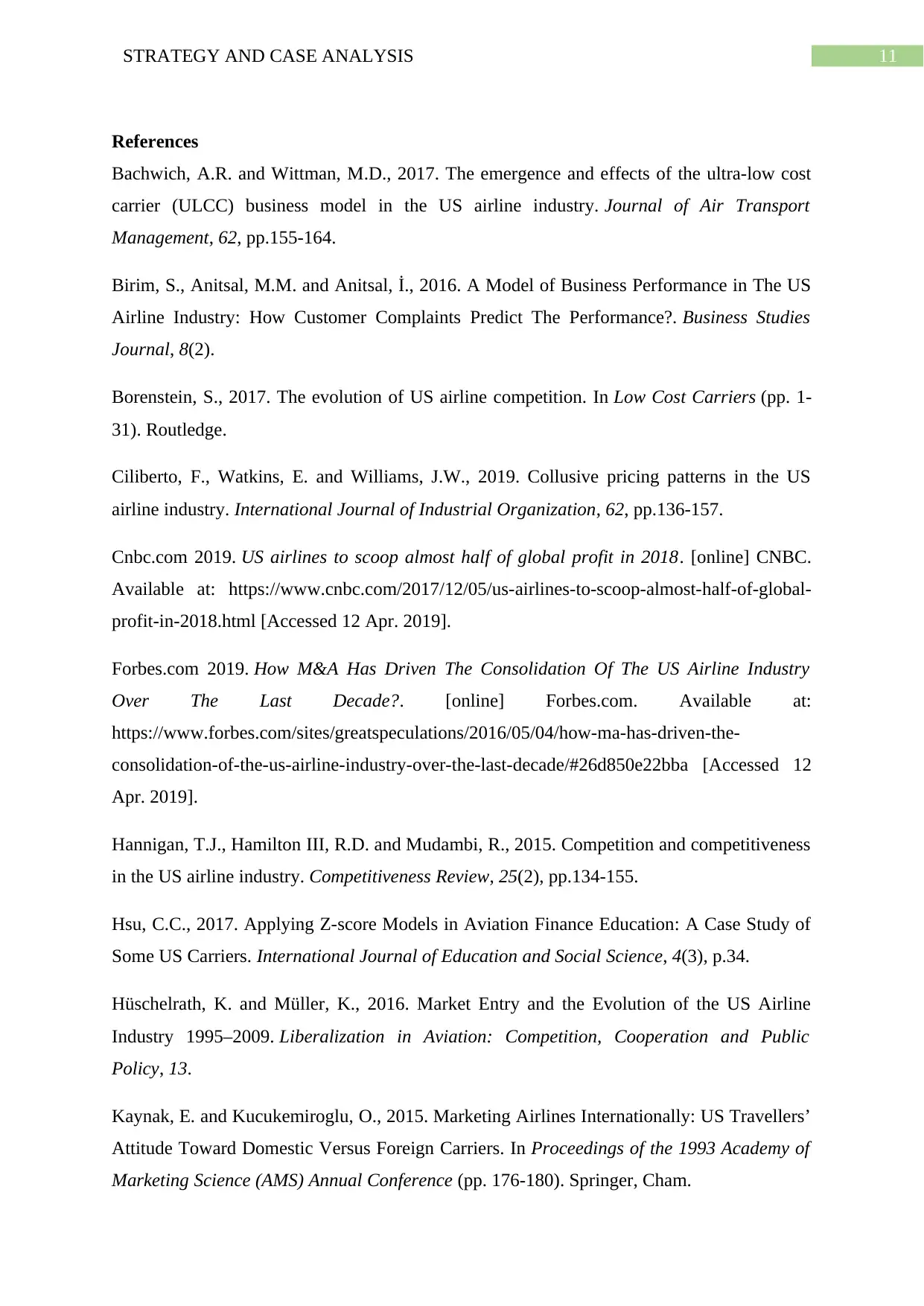
11STRATEGY AND CASE ANALYSIS
References
Bachwich, A.R. and Wittman, M.D., 2017. The emergence and effects of the ultra-low cost
carrier (ULCC) business model in the US airline industry. Journal of Air Transport
Management, 62, pp.155-164.
Birim, S., Anitsal, M.M. and Anitsal, İ., 2016. A Model of Business Performance in The US
Airline Industry: How Customer Complaints Predict The Performance?. Business Studies
Journal, 8(2).
Borenstein, S., 2017. The evolution of US airline competition. In Low Cost Carriers (pp. 1-
31). Routledge.
Ciliberto, F., Watkins, E. and Williams, J.W., 2019. Collusive pricing patterns in the US
airline industry. International Journal of Industrial Organization, 62, pp.136-157.
Cnbc.com 2019. US airlines to scoop almost half of global profit in 2018. [online] CNBC.
Available at: https://www.cnbc.com/2017/12/05/us-airlines-to-scoop-almost-half-of-global-
profit-in-2018.html [Accessed 12 Apr. 2019].
Forbes.com 2019. How M&A Has Driven The Consolidation Of The US Airline Industry
Over The Last Decade?. [online] Forbes.com. Available at:
https://www.forbes.com/sites/greatspeculations/2016/05/04/how-ma-has-driven-the-
consolidation-of-the-us-airline-industry-over-the-last-decade/#26d850e22bba [Accessed 12
Apr. 2019].
Hannigan, T.J., Hamilton III, R.D. and Mudambi, R., 2015. Competition and competitiveness
in the US airline industry. Competitiveness Review, 25(2), pp.134-155.
Hsu, C.C., 2017. Applying Z-score Models in Aviation Finance Education: A Case Study of
Some US Carriers. International Journal of Education and Social Science, 4(3), p.34.
Hüschelrath, K. and Müller, K., 2016. Market Entry and the Evolution of the US Airline
Industry 1995–2009. Liberalization in Aviation: Competition, Cooperation and Public
Policy, 13.
Kaynak, E. and Kucukemiroglu, O., 2015. Marketing Airlines Internationally: US Travellers’
Attitude Toward Domestic Versus Foreign Carriers. In Proceedings of the 1993 Academy of
Marketing Science (AMS) Annual Conference (pp. 176-180). Springer, Cham.
References
Bachwich, A.R. and Wittman, M.D., 2017. The emergence and effects of the ultra-low cost
carrier (ULCC) business model in the US airline industry. Journal of Air Transport
Management, 62, pp.155-164.
Birim, S., Anitsal, M.M. and Anitsal, İ., 2016. A Model of Business Performance in The US
Airline Industry: How Customer Complaints Predict The Performance?. Business Studies
Journal, 8(2).
Borenstein, S., 2017. The evolution of US airline competition. In Low Cost Carriers (pp. 1-
31). Routledge.
Ciliberto, F., Watkins, E. and Williams, J.W., 2019. Collusive pricing patterns in the US
airline industry. International Journal of Industrial Organization, 62, pp.136-157.
Cnbc.com 2019. US airlines to scoop almost half of global profit in 2018. [online] CNBC.
Available at: https://www.cnbc.com/2017/12/05/us-airlines-to-scoop-almost-half-of-global-
profit-in-2018.html [Accessed 12 Apr. 2019].
Forbes.com 2019. How M&A Has Driven The Consolidation Of The US Airline Industry
Over The Last Decade?. [online] Forbes.com. Available at:
https://www.forbes.com/sites/greatspeculations/2016/05/04/how-ma-has-driven-the-
consolidation-of-the-us-airline-industry-over-the-last-decade/#26d850e22bba [Accessed 12
Apr. 2019].
Hannigan, T.J., Hamilton III, R.D. and Mudambi, R., 2015. Competition and competitiveness
in the US airline industry. Competitiveness Review, 25(2), pp.134-155.
Hsu, C.C., 2017. Applying Z-score Models in Aviation Finance Education: A Case Study of
Some US Carriers. International Journal of Education and Social Science, 4(3), p.34.
Hüschelrath, K. and Müller, K., 2016. Market Entry and the Evolution of the US Airline
Industry 1995–2009. Liberalization in Aviation: Competition, Cooperation and Public
Policy, 13.
Kaynak, E. and Kucukemiroglu, O., 2015. Marketing Airlines Internationally: US Travellers’
Attitude Toward Domestic Versus Foreign Carriers. In Proceedings of the 1993 Academy of
Marketing Science (AMS) Annual Conference (pp. 176-180). Springer, Cham.
⊘ This is a preview!⊘
Do you want full access?
Subscribe today to unlock all pages.

Trusted by 1+ million students worldwide
1 out of 13
Related Documents
Your All-in-One AI-Powered Toolkit for Academic Success.
+13062052269
info@desklib.com
Available 24*7 on WhatsApp / Email
![[object Object]](/_next/static/media/star-bottom.7253800d.svg)
Unlock your academic potential
Copyright © 2020–2025 A2Z Services. All Rights Reserved. Developed and managed by ZUCOL.





